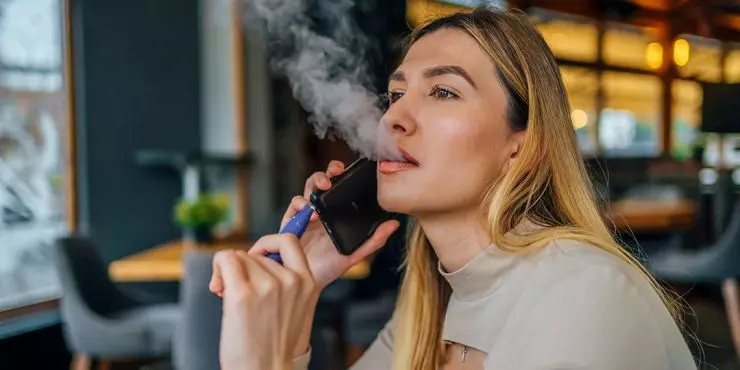
In recent years, vaping has gained significant popularity, especially among teenagers and young adults. Marketed as a “safer” alternative to traditional cigarettes, e-cigarettes and vape pens are often seen as a less harmful way to enjoy nicotine. However, as research continues to emerge, questions about the safety of vaping are becoming more urgent.
What is Vaping?
Vaping refers to the use of e-cigarettes or other devices that heat a liquid—usually containing nicotine, flavoring, and other chemicals—into an aerosol that the user inhales. The liquid, often called "vape juice" or "e-liquid," is available in a variety of flavors and nicotine strengths.
Unlike traditional cigarettes, which burn tobacco to deliver nicotine, vaping devices use a battery-powered heating element to create the vapor. This method was originally promoted as a way to help smokers quit or reduce their tobacco intake, but it has since evolved into a trend, particularly among young people.
Vaping vs. Smoking: Is It Safer?
While vaping is often marketed as a safer alternative to smoking, it’s important to understand the nuances:
- Fewer Toxic Chemicals: Traditional cigarettes contain thousands of harmful chemicals, many of which are known carcinogens. Vaping does expose users to fewer toxic chemicals than cigarette smoke, but that doesn’t mean it’s entirely safe.
- Nicotine Addiction: Many e-cigarettes contain nicotine, the addictive substance found in cigarettes. Nicotine use during adolescence can harm brain development, impacting areas of the brain responsible for learning, memory, and attention.
- Potential for Long-Term Harm: Since vaping is a relatively new phenomenon, researchers don’t yet know the full extent of its long-term health effects. However, there is growing evidence that vaping can lead to serious lung injuries and cardiovascular issues.
Health Risks of Vaping
Though vaping may seem like a safer option than smoking, it still carries several significant health risks. Here’s what parents and young adults need to know:
Nicotine Addiction
Many vaping devices contain high levels of nicotine, sometimes even higher than in traditional cigarettes. Nicotine is highly addictive, and young people who start vaping may quickly develop a dependence on it. This can lead to nicotine withdrawal symptoms, such as irritability, anxiety, and difficulty concentrating.
For young adults, nicotine use can have long-lasting effects on brain development, which continues into the mid-20s. Adolescents exposed to nicotine are at a higher risk of addiction to other substances later in life.
Respiratory Issues
E-cigarette use has been linked to several lung-related issues. In recent years, a condition called EVALI (E-cigarette or Vaping Product Use-Associated Lung Injury) has emerged, causing severe lung damage in some users. Symptoms of EVALI include coughing, shortness of breath, chest pain, and, in some cases, hospitalization.
Additionally, the aerosol from vaping devices contains harmful chemicals, such as volatile organic compounds and heavy metals, which can irritate the lungs and lead to breathing problems.
Cardiovascular Risks
Vaping can also affect heart health. Nicotine raises blood pressure and increases heart rate, both of which can strain the cardiovascular system. There is growing evidence that regular vaping may increase the risk of heart attacks and strokes, particularly in individuals with pre-existing conditions.
Harmful Chemicals
While vaping may expose users to fewer harmful chemicals than smoking, e-cigarettes still contain several toxic substances. Some of these include:
- Diacetyl: A chemical used in flavorings that has been linked to a serious lung condition called "popcorn lung" (bronchiolitis obliterans).
- Formaldehyde: A known carcinogen that can form when the liquid in vaping devices is heated to high temperatures.
- Heavy Metals: Some vaping devices contain metals like lead and nickel, which can leach into the aerosol and be inhaled by the user.
Impact on Mental Health
Nicotine addiction can have a negative impact on mental health, especially for young people. Vaping may worsen anxiety and depression, and the cycle of nicotine addiction can make it harder to manage stress. In some cases, young people may turn to vaping as a way to cope with mental health challenges, creating a harmful loop of dependency.

The Appeal of Vaping to Young People
Vaping has become particularly appealing to teenagers and young adults due to several factors:
- Flavors: E-cigarettes are available in a wide range of flavors, such as fruit, candy, and mint, which makes them more enticing to younger users. Many teens report trying vaping specifically because of the flavors available.
- Perception of Safety: Many young people believe that vaping is safer than smoking, and the sleek design of devices like JUUL makes them look modern and harmless.
- Peer Pressure and Social Media: Vaping is often glamorized on social media, where influencers and peers post images and videos of themselves vaping. This can create peer pressure for young people to try vaping in order to fit in or appear "cool."
Talking to Teens and Young Adults About Vaping
As a parent, it can be challenging to talk to your child about vaping, especially if it’s already a popular trend among their peers. Here are some tips for starting the conversation:
- Educate yourself about the risks of vaping so that you can provide accurate information. Your teen may have misconceptions about vaping’s safety, and it’s important to correct them with facts.
- Approach the conversation without judgment or anger. Let your teen know you’re concerned about their health and well-being, and give them a chance to express their thoughts and feelings.
- Rather than focusing on punishment or guilt, emphasize the health risks of vaping and how it can affect their body and brain development. Discuss the potential long-term consequences and how addiction can impact their future.
How to Quit Vaping
For young people who have already started vaping and want to quit, it’s important to have support in place. Here are some steps to help:
- Set a Quit Date
- Find Support - Find a friend, relative, or online support to help you quite
- Identify Triggers - Understand what causes you to want to vape and do your best to avoid them
- Use Resources - such as Smokefree Teen, that offer tips and support for quitting vaping.
- Seek Professional Help
Do Your Health a Favor, Don’t Vape
As research continues to emerge we are seeing more negative implications of vaping. Overall, there are no current health benefits of vaping, so do your wallet and your body a favor and stop vaping today. Find more resources on quitting today.
If you or your child is concerned about vaping or needs help quitting, don’t hesitate to reach out to a us. Protecting your health is always our top priority.